(nothing herein is a paid advertisement, nor am I selling designs or traps)
One of the most indispensable tools for a lepidopterist is their light trap. While collecting at a light sheet is useful (and fun), it does not provide the utility of a trap simply because it is impractical to remain attentive at a sheet for all hours of the night (I’ve only done it a few times!). Any sufficiently designed trap is a force multiplier and will increase your catch 100 fold all while being much easier to deploy in the field. No one could ever catch this many moths at a sheet in one night! (yes that bag is also full)
For years I have purchased and used the bulletproof designs of Leroy Koehn at Leptraps.com. I own a few of his traps and they have spent thousands of hours working overnight for me everywhere I have traveled to collect. If you can afford his traps they are worth it – the vanes are indestructible and the ballasts have an integrated photoelectric switch. The rain drains can also handle a monsoon, although I believe they allow for too much air-circulation and diminish the effect of your killing agent (usually Ethyl Acetate). On the downside Leroy’s traps are bulky and expensive, so not practical to deploy in large numbers. BioQuip does have a more affordable option for a 12 watt DC trap starting at $160, however I do not like their rain drain design, bulb type, nor acrylic vanes; although the bucket can easily be modified if desired.
The quick and easiest trap is just a light on a bucket! No vanes, no strange mechanism – nice and simple. Actually I’ve completely abandoned the use of vanes lately since I notice zero difference with catch results.
But if you’d rather stick to the old vein design here is what I’ve put together for a cheap-er version. Like every other entomologist out there I have tinkered with my own trap design and have attempted to redesign the mousetrap. Here is my proto-prototype vein design. Any advice is welcome, and I would love to see other designs and share them here!
The basic design is two PVC caps that snap onto acrylic vanes – the caps are connected by bungee cords that perfectly hold the vanes in place while allowing for quick and easy assembly and dis-assembly. The vanes then fit tightly in a 10″ funnel held onto the 2 gallon bucket by shortened mini-bungees. Any UV bulb can then be dropped into the vane assembly (in this case a BioQuip light). The diameter of the vane opening at the bottom is slightly narrower than at the top, providing a very snug cavity for the bulb. Cardboard egg cartons or towel padding has to be added to the bucket to provide insect resting area.
Cost: Bucket and vane assembly is $56.37. (w/o tax) – the standard 15w light from BioQuip it is $60.70. Total price is ~$117.
Advantages: Lightweight, small. The only limiting factor is the size of stacked buckets, about 12 traps require the same storage space as 2 rigid built traps. Vanes collapse to be negligible in size, the smaller 2 gallon buckets are better suited to a less-abundant fauna but can be upgraded to 3 1/2 or 5 gallon sizes for appropriate areas (mounting the funnel onto a lid of a larger bucket is all that is required). Broken vanes can be replaced in the field with cardboard or wooden backups can be prepared ahead of time. Cheap!
Disadvantages: Acrylic is not durable enough for long term use, the ideal material would be aluminum. Joints on the acrylic had to be reinforced with strapping tape – thicker acrylic might be better…. The bucket and vanes are so light that it must be staked down in the field. Poorly made by a non-engineer.
Now for more detailed specifications:
Supply list, purchased from your local “mega hardware store”.
2 gallon bucket $3.58
2″ x 2′ PVC pipe $3.69
.093 – 20 x 32 Acrylic Sheet $ 13.98 ea (thicker would be better)
10″ funnel (from brewing supply store) $17.98
1/2″ x 2′ PVC $0.99
1/2″ PVC coupling $0.25
mini bungee 8 pack $2.47
fiberglass screen $5.98 – for rain drain
small funnel (from auto-supply store) $1.98
Plastic epoxy $5.47
10′ of 4mm bungee cord – minimum order $20. (left out of total, rope can be used for a cheaper cost)
Tools required:
Dremel tool for cutting grooves in PVC and acrylic
PVC pipe cutter – for both 2″ and 1/2″ pipes.
Acrylic/Plexi cutting knife (helpful video for cutting)
Drill with 13/65 bit for holes
Safety glasses!
Batteries:
My favorite batteries for powering these 15 watt bulbs are sealed lead acid (SLA). They are smaller, lighter in weight, are FAA approved for air travel, and don’t leak acid all over your car and clothing. They are also pretty cheap. If you explore your local battery suppliers you can usually find these for about $40.
For regular use I use this 18 amp-hour 12V battery: $34.95 before shipping. The 18ah rating provides a full night of light with enough buffer to extend the length of the battery for a few years. The less percentage you can discharge a battery the longer it will last.
For international trips a 14ah battery is better. They are slightly smaller and lighter and will provide about 7 1/2 hours of light before becoming exhausted. Because you are fully discharging the battery they will not last as long.
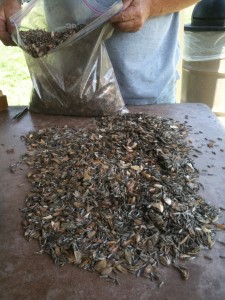
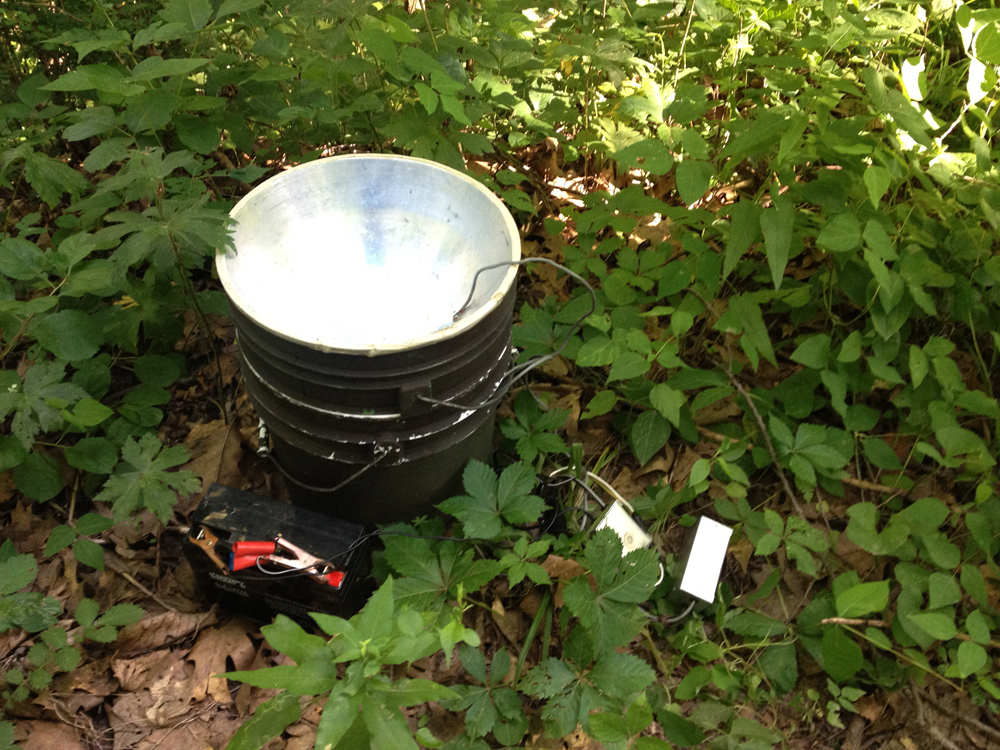
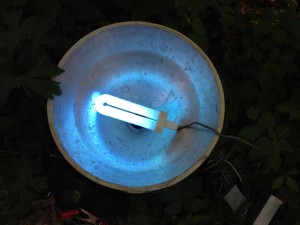
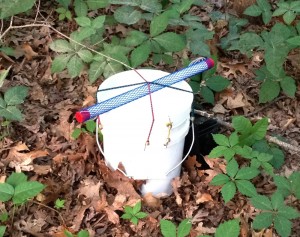
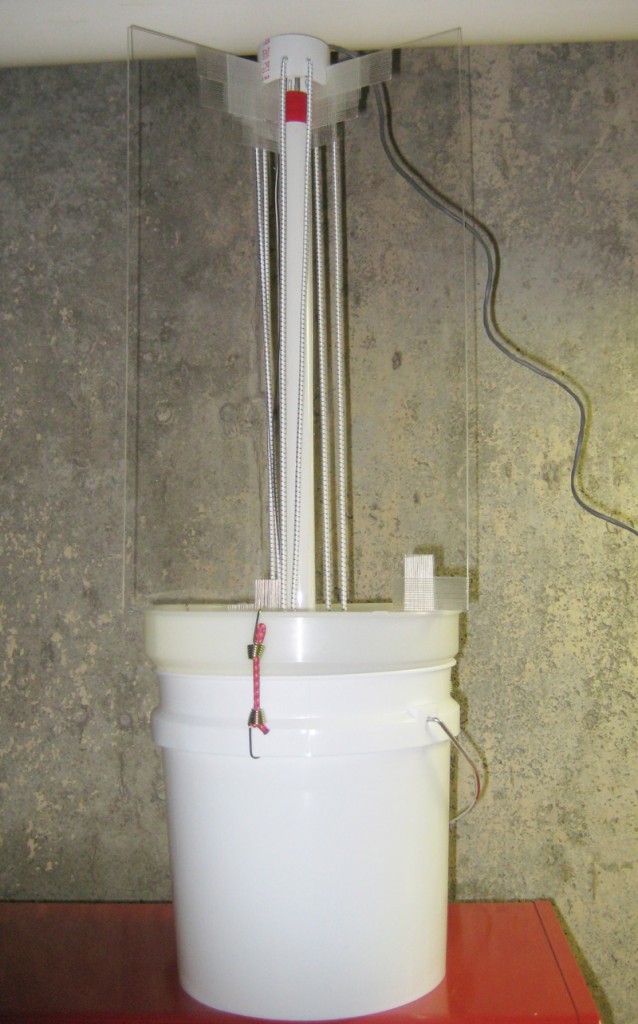
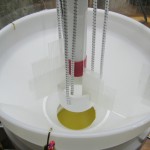
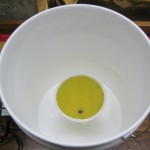
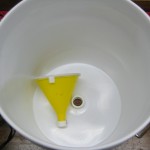
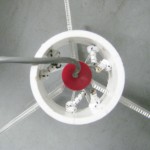
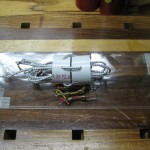
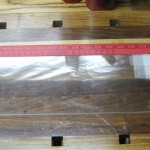

Hi,
Was wondering if you knew of something very portable and waterproof or resistant and battery powered?
I live in an urban area and a dont have a power source near any kind of woodsy area.
I would like to be able to setup something in the woods at a local regional park but worry about overnight rain. It rains infrequently here. The park is 20 miles from my home.
Was thinking of something that involved a high power UV flash light.
The combination of a 15w UV bulb from BioQuip and any motorcycle/wheelchair battery will do the trick. I’ve used these in heavy rain without problem – I just be sure to cover the battery terminals with a tarp to prevent heavy water from shorting the connection. Moisture has never given me a problem with this gear.
Thank-You! Do you just place the battery on the ground? Also what sort of trap should, I incorporate the bioquip 15 watt light into?
Yes – directly on the ground works perfectly well. As you see above I simply place the 15w bulb over a funnel on a bucket. No fancy gadgets – if you know or are afraid of rain you can build a rain-drain into the bottom with a small funnel. Placing a ping-pong ball within the funnel will act as a seal (but will float and drain water if it rains). Happy hunting!
Thanks very much Chris! Just one last question and I will stop bothering you. When it comes to your light over the bucket trap do you have a funnel of some sort resting underneath the light and bungee cords and what is it exactly or where can it be gotten? Thanks!
Always happy to answer questions! BioQuip makes a very nice funnel that fits a larger 10g bucket (the funnel is a bit long, so a shallow 5g bucket doesn’t leave enough room in the bottom), the lip of the funnel seals perfectly to the bucket. It’s a bit expensive, so honestly *any* funnel over any bucket will get the trick done. Add a few egg cartons or paper towels to absorb any condensation and to provide the moths a hiding space. And the bungee chords just hold everything together in case a light breeze comes along or something – it’s good to make sure the light doesn’t fall off your bucket and ruin a night of collecting!
What do you use to charge these batteries for the next nights hunt? Thanks very much!
Any variable rate battery charger will do, mine has a 2, 4 & 6 amp setting. When I’m not in a rush I charge at 2 amps to save battery longevity. 6 amps is fast but will cause faster degradation of the cells. You can pick these up at any automotive store.
Hello,
Years ago I made an incandescent light trap that worked pretty well in the UK ,and now I am starting afresh with a grandchild in Vermont.
Are the bio quip bulbs significantly superior to say a cheaper bug zapper bulb? We tried just a white ryobi led lantern last night without too much success…would wrapping the lantern in blue tissue paper likely improve the attraction?
Also the brewing funnels I already have , have a very long stem.i would like to,be able to,trap the largest moths. Do,you trim the stem a few inches shorter so the opening is larger? If so , to what diameter approx?,
Thanks!!
The BioQuip bulbs are your best bet because they are built to withstand weather a lot better than a bugzapper light (that has to be removed from the case). Never had a bulb go bad in the rain! Wrapping a bulb in colored paper will only give you colored light, not the best spectrum for attracting lepidoptera. A UV light has a broadened spectrum peaking at 350 nanometers. The blue isn’t what’s actually attracting the moths, it’s the UV light we can’t see (blue is around 470nm). And I do trim down the funnel size to make it larger, but you don’t need it very big – an opening of 1.5″ is significant even for a very large moth!
Thank you for the great information and interesting articles.
Regarding the blacklight that you show that is 8 watts in the first picture, where do you get something like that? Is that DC or did you have to use an inverter? I see various blacklights on Amazon that are half the price of the Bioquip version but they are AC. I don’t mind paying for the Bioquip one (I actually have one for the regular blacklight setup) but would hate to buy something that can easily be stolen when unattended.
Thank you for any tips,
Thanks for the speedy response! So, is 1.5″ opening on the funnel big enough for even the larger silk moths ? (We were not so lucky to have those in England! Emperor moths notwithstanding )
Hello Chris,
Thank you for shearing this information! I’m wondering how you connect your 15 UV lamp to the SLA batteries? What type of wiring can be used?
Thanks!
I use something along the lines of this: http://www.amazon.com/Optronics-Adapter-12-Volt-Battery-Vehicles/dp/B000AU8LVA/ref=sr_1_2?ie=UTF8&qid=1405575029&sr=8-2&keywords=dc+battery+adapter
Basically any DC to “alligator clip” adapter. There is a wide variety of alligator clip sizes so I suggest buying them in person at a store, but you just need ones that will fit your battery terminals (the ones on my SLA batteries are slightly recessed and the clips need to be narrow enough to fit). I’ve never had a problem with them coming off of the trap at night.
Thank you for Your answer, Chris!
Now I have a 12V18Ah battery, a 12V battery adaptor with alligator clip and a 15W blacklight tube. What should I use to connect this blacklight tube to my 12V battery adapter – they are not passing to each other? (As you can see I’m not an electrician at all)))
Hi Anton- Did your black light come from BioQuip? It should have either a car-charger style plug (DC) or a regular house plug (AC). If you have the AC version perhaps it is best to return it for the DC version. Or you need an ac/dc converter so you can plug everything together. Or you need to run a power cord to plug your bulb into the electricity.
Good-morning,
A couple of questions as I try to rig up some traps:
Does funnel color make a difference? Are those metal (aluminum?) funnels/light casings good?
I was just planning to go with a ‘light-over-bucket’ approach, do you find your catch a lot lower with those vs. the upright design?
Thanks,
Conrad.
I don’t think the color of the funnel makes a difference, but the metal ones from BioQuip are very nice (they fit a larger 5 gallon bucket). I think a dark or metal funnel keeps light out of the bucket and helps the moths settle down when they enter.
I see no appreciable difference with the upright vs. flat over the funnel. I would encourage you to try different trap designs, but my traps at the LepCourse this past week (the only ones with bulbs flat across the funnel) caught the exact same number and types of moth as the ones with an upright design with vanes.
Hi Chris,
Thank you for the great information and interesting articles.
Regarding the blacklight that you show that is 8 watts in the first picture, where do you get something like that? Is that DC or did you have to use an inverter? I see various blacklights on Amazon that are half the price of the Bioquip version but they are AC. I don’t mind paying for the Bioquip one (I actually have one for the regular blacklight setup) but would hate to buy something that can easily be stolen when unattended.
Thank you for any tips,
Garin
Garin-
The 8w above was wired by a friend of mine to DC, the bulb is something along the lines of this: http://www.elightbulbs.com/General-00866-FUL8T6-BL-U-Shaped-Fluorescent-Black-Light.
My go-to light is the 15w DC BioQuip bulb as shown in the last photo. It does seem to pull in more than the 8w, and is pretty rock solid. And there isn’t much you can do to secure your trap other than do a good job of hiding it. If you’re in a higher-traffic area consider using a “dark” black light bulb. But you will lose a trap some day! In all of my collecting events I’ve only had one trap go missing.
Thanks for the tips, much appreciated.
Sorry, one other question. With the light trap, are you still able to collect large silk moths? What minimum size diameter is needed at the smallest part of the funnel opening in order to catch the larger silk months?
I have never done the light trapping but when I see pictures of it, it almost seems like there are tons of small moths and never any big ones.
Thanks again,
Garin
I also have been using the BioQuip funnel part #2851B. It’s expensive, but the best quality funnel I’ve been able to find. It fits perfectly on a 5 gallon bucket (12″).
The diameter at the narrow end is probably 2″, and will allow for Saturniidae to fit. Think body size, not wing span. I’ve gotten good specimens of Citheronia, Hyalophora, Eacles, Actias, etc… However, bucket trapping is NOT the best way to trap large moths. Big silk moths tend to bounce around a light and settle around it, so in the morning you can often find more Saturniidae outside the trap than inside. If you only want big moths then consider getting a mercury vapor sheet rig.
Thank you! Great information.
I am planning a trip to southern Arizona this summer so will let you know how it goes.
Thanks for your awesome site!! I have been looking everywhere for an affordable light trap option. I plan to have my father, who is skilled at wiring, build this for me.
I don’t know if you still check this page or not..but! Are there any safety issues involved with leaving a setup like this in the woods overnight? I’m a worry wart and I could see me leaving my trap in my local public park overnight and not being able to sleep due to worrying that I’m currently burning down the entire forest 🙂
I’m a field biologist who works with birds who has to take the summer off so I’m working with my moth obsession to fill up my time. I’d really like to start compiling some species data for the county I live in, and unfortunately my back yard is lacking in some key habitat. I’m itching to trap some local areas.
Thanks!
Hi Beth- you should take normal precautions when placing your trap to avoid dry plant material packed around the battery and ballast. I usually step down a little clearing or brush away plants if I’m placing the trap in dry grasses or leaves. The ballast gets a little warm but never would be hot enough to start a fire. The battery could potentially spark should it be disturbed, but use tight fitting alligator clips or bolts to attach your wiring to the leads. I’ve never worried about it and have trapped in the direst of California’s summers.
Have fun!
hi were can you get the light i want the light bulb and the thing you use to light it up an you give me links or places where you can get the light bulb + the thing you use to light it up thanks
Bioquip has a decent DC powered light, and you can pick up a 12v 18ah “wheelchair” style sealed lead acid battery along the lines of http://www.batterymart.com/p-12v-18ah-sealed-lead-acid-battery-1.html
Have you ever compared an actinic catch with a MV bulb? Everytime I do so I get ten times as many in the MV trap. Pain in terms of power sources though.
You’re right that MV/HgVPR does very differently and often has more numbers of specimens. I find that for smaller moths a smaller actinic bulb works better. But a combination of both is sometimes smart. I like to run a HgVPR bulb on a sheet with a 15w UV bulb on a trap underneath it.
Hi Chris,
Thanks for all the good information! I will be night-lighting in Madagascar this summer as part of my dissertation project and am trying to determine the lightest, cheapest options. I am liking your set-up of just a bucket and a funnel with a light and car battery, I can get both the buckets and the batteries in the field. What would you suggest as far as bioquip lights that will work well with a typical car battery I can pick up in Madagascar? I know it is best to use a variety of spectrums, what kind of lights/spectrums do you favor? I will be trapping in the rainforest (very rainy) and saw in previous comments that you suggested cutting a rain drain in the bucket, do you have any other preventative measures for rainy conditions you would suggest? Do you generally put ethyl acetate inside the bucket, or do you just collect live? I will be going on 10-14 day expeditions with no access to any power source, how long would you estimate 1 trap would last and what would you recommend as far as battery chargers? As you can see my main problems are portability, long expeditions without power and very rainy conditions. Any advise you can give would be greatly appreciated.
Thank you!
Hi Amanda-
Sounds like an amazing project, I’d love to hear more about it! I use the standard BioQuip 15w UV bulb with the DC plug. I have noticed in the last 5 or so years the quality from them isn’t what it used to be, so be sure to buy spare bulb setups and test them before bringing into the field. But when they work they run well even when it’s wet. A rain-drain will be necessary – I basically screw a funnel into the bottom of the trap and screen off the top to prevent escapees. And yes I do kill-trapping only usually with Ethyl Acetate (which might be very hard to get in Madagascar). I’ve used Chloroform before in Europe that was OK – but Ammonia Carbonate might be a better bet. You can fill socks with 1-2 pounds of carbonate powder and dampen. It takes a LOT to kill in a trap, but it can work well. Live trapping only works when it gets cool out at night and moths have a chance to settle in the bucket. If you get lots of abundance, the trap turns into a tornado of moths and it’s a complete disaster. Even with a killing agent light trapping can be really hard with high abundance. In southern Arizona or Texas I use 2-3 cans of Ethyl Acetate and some nights the moths are too thick for the bucket trap to handle. During those trapping nights I have to swap out the buckets every 1-2 hours to prevent the specimens from tearing themselves up.
Even though this is not regarding light traps, but does anyone know where one can acquire or buy pheromones for satuniids? I figure it would be expensive, but good to find areas where some of these moths would be. Any help would be appreciated.
Angleps if you’re in the UK
Hello I will start to collect Helicoverpa armiguera in field but I am not sure if the “bucket trap” will be the right one for me. H punctigear can reach 1-2 km above the ground when they are flying. So this trap is particularly special for moths with ground level flights?
thanks a lot for your help
These traps only pull in moths flying through a bubble of a few meters, probably not more than 2-3m, but a 15w light is not super powerful. For agriculture trapping you can elevate the trap above the crop on a stand (which allows the light to be more effective at a greater distance), or you can use more powerful light – 30w or mercury vapor.
Hi Chris,
Thank you for sharing all of these details about trapping moths that are usually left out of the publications I have come across. We are trying to prevent Stripped Oak Caterpillars from stripping all the foliage off of the 20 acres we planted in hardwoods using a CREP program through the NRCS. Because we live on highly erodible soil, having the trees planted on the slopes and drainages prevents sedimentation of the streams and ultimately, the Chesapeake Bay. When asked what hardwoods I wanted I responded “Oaks!” So, while were have a half a dozen species of Quercus, I have essentially created a monoculture.
20 odd years after having been planted, having survived drought, damping off, rodent damage, deer nibbling and rubbing, those trees that have made it to standing 20 – 30 feet high face a new threat: The orange stripped caterpillar which can defoliate a tree in 3 weeks.
We have been picking them off by hand for several years when we had the good fortune to hire a recent graduate student from Va. Tech who has a degree in entomology. He suggested we add blacklight traps to help nap the female moths before they begin laying eggs.
We are planning on placing three of the more powerful blacklight traps in the open hay fields where they will be visible to all. I don’t want to get rid of the beneficial moths and insects, so this trap is perfect for our needs. We can’t use insecticides as the farm has been used for the last decade by James Madison University to band songbirds and study catbird behavior. In one interesting study in 2018, students placed 10 tiny GPS transmitters on catbirds to discover migration patterns. They were able to pinpoint exactly the location in Cuba to which the birds travel during the winter. 6 of these transmitters were taken off netted birds the following year.
Wishing you an abundance of time spent outdoors, and again, thank you.
Light traps may not be all that effective for control of Anisota. In general light trapping is only useful as a monitoring tool – to know when females may be flying, but you’ll mostly catch males. Females may not fly far until ovipositing the majority of their eggs. I would also say that it is a misnomer that moths are not beneficial – they are important pollinators of many species and are turning out to be just as effective as other “better known” pollinators. Your traps may have a handful of Anisota specimens and hundred+ other species. And even super heavy light trapping appears not to have a significant impact on moth populations. Unfortunately your best option may be manual removal of egg masses.
Thanks for all the useful info. We are now successfully trapping the orange stripped oak worm moth before she can lay eggs thus helping us save the 45 acres of trees we have on this highly erodible shale soil here in the Chesapeake Bay watershed. A good way to keep moths in the 7 gallon buckets so they can be examined and target species selected is to use plastic sleeve from the drycleaner. Duct tape this around the top of the bucket tightly. rollup when the funnel and light are in place. In the morning pull plastic up and over the funnel. Turn to the side and carefully remove funnel keeping moths inside bucket. Then this clear plastic sleeve allows you to see what is captured and insert hand and arm in to retrieve individual moths or beetles. I’ll be happy to send a photo if you need it.
Again, thanks for all the suggestions.
From the Shenandoah Valley, VA
Hi Chris,
How much ethyl acetate is needed in a for a funnel/bucket trap left over night? Does it just go in an open jar inside the trap?
Thanks for your time,
-Ryan
For a normal trap night I’ll put a cup with ~6-8oz of acetate. It’s in a closed wick-can, which can be any container with a wick. Find something squat and low so it won’t tip over that has a plastic screw-top lid. Then I drill a hole maybe 1/2″-ish. I roll up paper towels and use those as a wick since they need replacing once in a while. Scales can build up on wicks and prevent evaporation. The bottom of the towels should touch the bottom of the inside jar and have at least 2-3″ of towel on top. This will provide a nice steady stream of acetate. You could use a cut-to-shape sponge or even a thick cotton rope. If you expect high abundance of moths I usually then add at least two cans per trap. Be sure your rain-drain isn’t too big either, you don’t want lots of air to escape.
Hi Chris, I to run some of Leroy’s Traps. I have cut sponge to fit inside the drain pipe. It still drains rain water but saves your EA.
Thanks for the great site, Tim
Thanks. Yes I would stuff that drain pipe with toweling or something, but a big sponge sounds better!
Hi Chris,
Thank you for this information; this has been very helpful! I am going to be doing a moth survey this summer and plan on using 3 light traps built similar to the ones you describe. Not sure if this is possible, but do you know of a way to identify and count all of the moths without killing them? My plan was to save one specimen of each species, but I didn’t know if there was a way to somehow release the rest alive.
Thanks in advance!
You should explore this project: https://stangeia.hobern.net/autonomous-moth-trap-project/
Many light trappers in the UK also do live-trapping (especially in cool temps), if you line your bucket with a lot of egg cartons and keep it nice and dark you can have moths that stay nice and calm all night (a dark bucket and a metal or dark funnel help). I imagine however that at a certain temperature the bucket will just be too warm and moths will be too active and beat themselves up flying in a confined space.
Hi Chris,
Does the BioQuip DC light stun the moths? What actually causes them to fall into the funnel?
This is such an informative page. I am building a light trap myself, and your responses to the other comments have answered a lot of my questions!
Thanks, Lucy
I would like to lower the population of asian garden beetles in my garden (they come out to feed at night) and have been thinking of a light trap as a possible solution. I’m concerned about unintentionally harming beneficial bugs/insects. Is there a way to construct a trap that might target the beetles (pests) but spare the rest?
Hi Alison,
There isn’t really a way to build a light-trap only for beetles, and it definitely would collect anything that came to the light which would mostly be moths. There are however lots of effective Japanese beetle traps with baited lures that are super effective. I don’t have a brand or recommendation other than going with a reliable supplier online or pest-control company.
Hola Chiris Grinter,
Gracias por toda tu experiencia recopilada de trampas de luz para que sea más ameno para algunas personas(a mi no me importaría leer un libro entero de este tema).
Estoy creando una trampa de luz tipo sabana para observación y me falta las 2 cosas más importantes de esta.
1: La luz. Sería exactamente la luz UV de la página EntoSphinx(modelo 3.11). ¿Sería suficiente para una trampa de luz? ¿Necesitaría una bombilla de Mercurio?(Vivo en España y como mi país está metido en UE no se producen y sólo quedan las que quedan).
2: La sábana. En la pagina/tienda online de EntoSphinx(cuesta 78€) lleva con todo pero me parece muy caro el precio. ¿Me podrías decir que sábana especifica y de qué material están hechas? Además, si no es mucho pedir, ¿podría mandarme un enlace de una sábana con ese tejido específico?. Por lo que he leído, la sábana hace que refleje más la luz UV y la luz blanca añadiendo que se puedan posar fácilmente los lepidopteros que vengan atraídos por la luz. ¿Me equivoco?
Lo siento muchísimo por todas las preguntas que te hecho. Quiero tenerlo todo bajo control y que salga perfecto.
Soy nuevo en la trampa de luz y estado mirando prácticamente en todos los sitios de Internet y sigo entender estos 2 materiales.
Disculpa las molestias y por el texto tan largo.
Saludos
Gael.
Hola Gael,
La luz no es muy importante, puedes empezar primero con una luz UV de baja potencia. No se requiere una bombilla de mercurio y puede ser difícil instalarla con una línea eléctrica, aunque atraería más polillas más grandes (las luces más pequeñas pueden ser mejores para las polillas más pequeñas).
Y la tela de la sábana no tiene ninguna importancia. Cualquier tela blanca sirve. Tomo una sábana barata y la ato entre dos árboles, eso cuesta sólo unos pocos dólares.
Buena suerte!
This is so helpful! Thanks Chris
Hi Chris, now that Bioquip is out of business, I am looking for a replacement (or additional) UV blacklight that I can buy that can also be battery powered like the DC light I have from Bioquip. Any suggestions. I am planning a trip to SE Arizona this summer and would like to get 2 nights of sheet collecting in if possible. Thank you for your help.
No one seems to be making the 15w replacement bulbs, although there is a DIY ballast/setup here that works great if you have access to a laser cutter (or want to make the box out of something else and possibly wire in a different photo electric switch). EntoQuip is making a UV version but it’s a bit more power-hungry than other LED bulbs and has an AC adapter as standard.